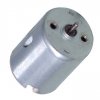I managed to build a h-bridge to drive a motor forward/backward. But the problem now, the motor turned forward/backward too much.
This motor is for robot one leg movement (forward/backward), so i need a nice movement/motor turn suitable for leg movement. My idea is to give a signal as shown in the attached picture.

I have not try it. Will this be okay? Or is there any nicer idea?
p/s: i use dc motor
This motor is for robot one leg movement (forward/backward), so i need a nice movement/motor turn suitable for leg movement. My idea is to give a signal as shown in the attached picture.

I have not try it. Will this be okay? Or is there any nicer idea?
p/s: i use dc motor



